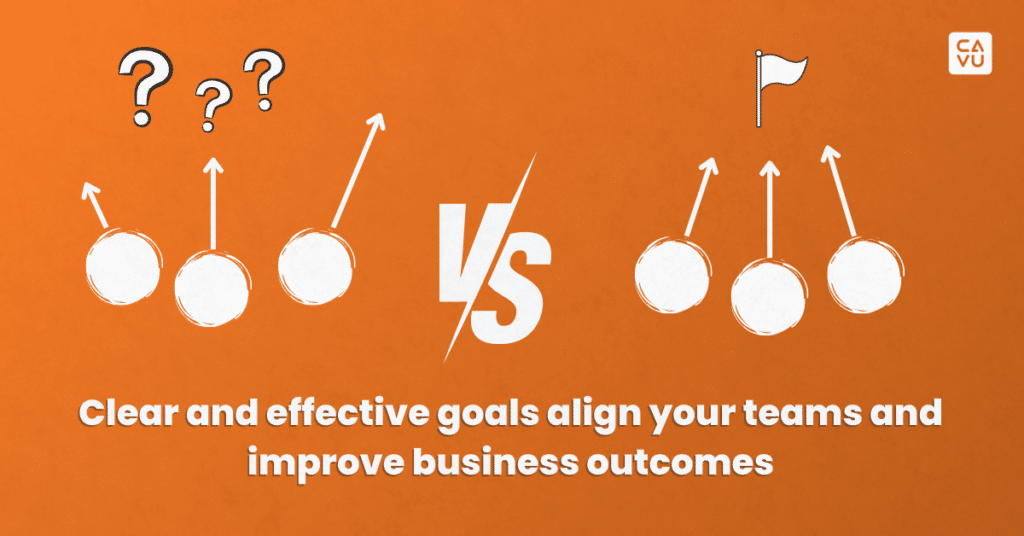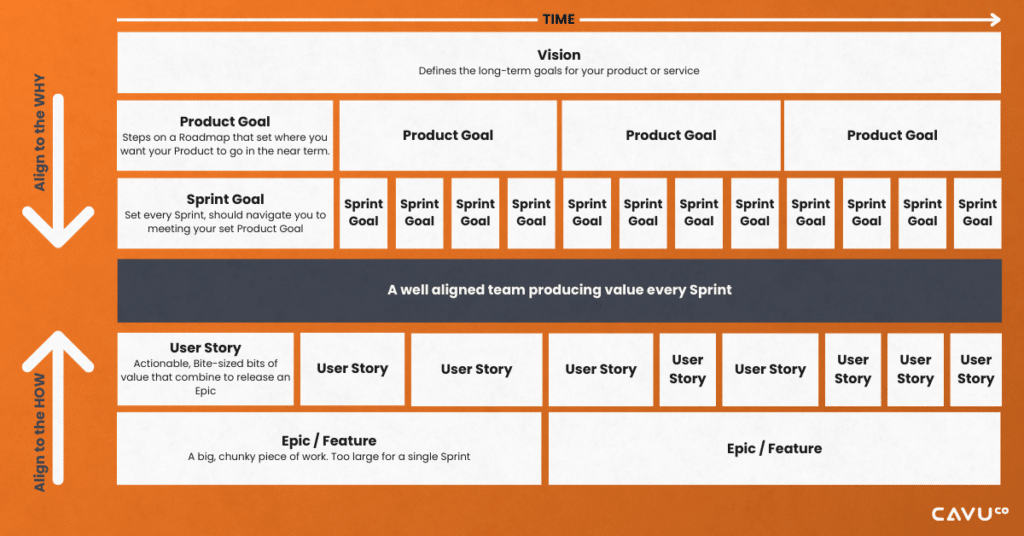In the world of Agile, goals aren’t just aspirations but the fuel that powers our journey towards excellence. When I was an early career Scrum Master just embarking on my path, I quickly discovered that setting clear, actionable goals is essential. Why? Because they bring clarity of purpose and align a team’s efforts, ensuring that every bit of energy contributes to a greater impact.
Let’s talk real-world scenarios – the kind you’ll face daily. Imagine you’re leading your first Sprint Planning session. Instead of a vague aim like, “Let’s try to improve our product,” you set a specific goal: “By the end of this Sprint, let’s develop a feature that simplifies user login.” See the difference? This isn’t just a goal; it’s a clear, measurable target that your team can rally around, and it would make a great Sprint Goal.
Or consider this: You’re not just aspiring to be a good Product Owner; you’re aiming to deepen your team’s understanding of your primary customer. Your goal becomes, “In the next two months, I will facilitate customer interviews and share insights with my team to ensure we’re laser-focused on enhancing user experience.”
And it’s not just about being a positive force; it’s about tangible impact. Replace “I want to be a positive change agent within my org” with “I aim to swiftly remove any impediments my team faces, aiming for resolution within a week.” This mindset transforms your role from a passive participant to an active problem-solver.
As we delve into the Agile approach, particularly the use of Epics, we’ll explore how you can apply these principles to guide your goals and those of your team. This isn’t about lofty theories; it’s about practical, hands-on strategies that you can start using today in your organization. So, let’s dive in and turn those goals into a reality, one Sprint at a time.
The Agile Approach

Let’s get straight into the Agile world with a practical lens, especially focusing on how you, as a new Scrum Master, Product Owner, or Team Member, can effectively work with your team on setting various goals, from Sprint Goals to professional development. We’ll break down key Agile concepts into simple, actionable steps, providing you with the tools you need to tackle large projects and transform them into manageable tasks.
Understanding Key Agile Terms:

- Vision: The big dream for your product or service. It’s the guiding star for all your efforts, the ultimate purpose you aim to achieve. As a PO, SM or Team Member, keep asking, “How does this align with our Vision?”
- Product Goal: Think of it as your roadmap in the Scrum Guide. This is where you want your product to be in the future. It’s essential to keep this in mind when prioritizing your Product Backlog Items (PBIs).
- Sprint Goal: This is your team’s focus for the Sprint. It’s a short-term aim that should always align with your bigger Product Goal. One way to choose your Sprint Goal, is to ask the question, “What could we present at our Team’s next Sprint Review that would get our customers and stakeholders excited about our work?
- Epic: A big, chunky piece of work, too large for a single Sprint. Breaking down Epics into smaller parts is where your skill as an Agile team member really shines.
- Feature: A substantial part of your product, often interchangeable with ‘Epic’ in software development. It’s a piece of work contributing to an Epic, composed of several PBIs or User Stories.
- User Stories: These are your actionable, bite-sized backlog items. They’re small enough to be completed in a single Sprint. They are sometimes written from the perspective of the end-user. Like this, “As a [some kind of customer], I want [some outcome], so that [some end goal or value].”
Using Epics for Goal Setting
As always, let’s start by understanding the “why.” Understanding why we use Epics can help to inform how we use them. Epics are your guiding stars for long-term goals. They represent broad objectives that span multiple Sprints, helping you to keep the bigger picture in sight while simultaneously working on the details.
Why Use Epics for Goal Setting?
- Why Epics Matter: While Sprint Goals keep you grounded and focused on the short term, Epics help you chart a path for future growth and development. They ensure your daily efforts contribute to a larger purpose.
- Vision Alignment: Every Epic you define should align with your overall vision. Think of Epics as chapters in your success story, each contributing a vital part to the overall narrative.
- Breaking Down the Big Picture: Just as you break down tasks for a Sprint Goal, you’ll break down Epics into smaller, manageable segments. This approach ensures that every step you take is a stride towards your overarching objectives.
Let’s delve into how you can effectively use Epics to set and achieve your long-term goals, keeping your Agile journey on a trajectory of continuous growth and success. Remember, the key is to start broad, dream big, and then distill those dreams into actionable steps.
Step 1: Defining Your Epic – How to Start
- The ‘What’ and ‘Why’: Begin by asking yourself, “What’s my big vision or significant goal?” and “Why is this important?” Aim to identify 1-3 key outcomes or aspects that resonate with your vision.
- Facilitating the Discussion: If you’re in a team setting, facilitate a brainstorming session. Ask each team member to share their ideas and collectively decide on the top 1-3 goals.
- Real-World Example:
- Vision: “Become a leading expert in multiple Agile frameworks.”
- Epics: “Develop a comprehensive online course on Agile,” “Write an e-book on practical Scrum techniques,” “Host monthly webinars on Agile best practices.”
Step 2: Generating Acceptance Criteria – Making It Measurable
- Setting the Criteria: For each Epic, ask, “What does success look like?” Create clear Acceptance Criteria that are specific, measurable, and achievable.
- Collaborating for Clarity: Discuss with your team or a mentor to refine these criteria. Make sure they’re realistic and align with your team’s capacity.
- Example for an Epic:
- Epic: “Develop a comprehensive online course on Agile.”
- Acceptance Criteria: “Complete module outlines by next month,” “Create interactive quizzes for each chapter,” “Pilot test with a small group and gather feedback.”
Step 3: Breaking Down the Work – The Art of Smaller Tasks
- From Big to Small: Now, break down each Epic into smaller tasks or User Stories. Think about the steps needed to achieve each criterion.
- Guiding Questions: Ask, “What’s the smallest step we can take towards this Epic?” and “How can this step deliver value?”
- Practical Example:
- For the Epic “Develop a comprehensive online course on Agile,” break it down into:
- Task 1: “Research existing Agile courses for inspiration.”
- Task 2: “Draft the first module outline focusing on Agile basics.”
- Task 3: “Design one interactive quiz for module one.”
- For the Epic “Develop a comprehensive online course on Agile,” break it down into:
Step 4: Measuring and Adapting – The Agile Way
- Setting Metrics: Define success metrics for each task. These could be qualitative (e.g., feedback quality) or quantitative (e.g., number of completed quizzes).
- Creating a Feedback Loop: Regularly check in on these metrics. Adapt your approach based on what you learn.
- Example of Actionable Steps:
- “Gather feedback on the first module draft from two Agile experts.”
- “Conduct a small focus group to test the interactive quiz.”
- “Revise the content based on feedback before proceeding to the next module.”
In Conclusion
Remember, in Agile, it’s all about iterative improvement and responsiveness to change. Start small, keep your goals clear and actionable, and don’t be afraid to adjust as you learn more. By breaking down your Epics into manageable tasks, you’re not just planning; you’re on a path to achieving your goals one step at a time. So, go ahead and start turning your vision into action today!
…did you find this approach to goal setting insightful? We’d love to hear your thoughts! Share your experiences using Agile for personal or organizational goal setting. Let me know in the comments if this method resonates with you or if you have other strategies that work well. Your feedback and stories are invaluable as we all strive to become more effective in achieving our goals.








